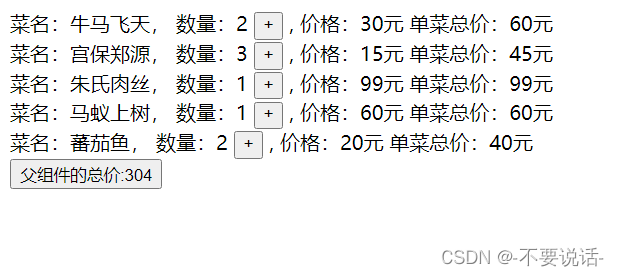Vue子组件向父组件传值
-不要说话- 人气:0首先我们可先了解一个父组件向子组件传值的一个案例:将父组件请求的后端数据传值给子组件props
因为通过属性传值是单向的,有时候我们需要子组件的data 数据需要交给父组件使用:通过在子组件上定义自定义事件,在子组件中通过$emit 来触发事件;子组件的事件被触发并传参,事件处理函数可以接收到子组件的数据;事件绑定的事件处理函数在父节点上,故可在事件处理函数中用到子组件的数据值来修改父节点的数据。
案例:
父组件
子组件触发事件 并传值 :
this.$emit("自定义事件,可以和原生事件同名:click",参数1,参数2,)
<Box @事件="fn"/>
<template>
<div>
<!--首先用v-for循环把值遍历出来 ,同时通过属性绑定将父组件的值传入子组件 -->
<!-- 绑定一个自定义事件 -->
<Box @mychange="change" v-for="(el,index) in arr"
:title="el.title"
:price="el.price"
:count="el.count"
:index="index"
:key="index"
></Box>
<button>{{msg}}:{{total}}</button>
</div>
</template>
<script>
import Box from "@/components/myheader.vue" //引入子组件
export default {
name: 'VueApp',
data() {
return {
msg:"父组件的总价",
arr:[] //必须提前给后端数据创建一个数据容器,不然在数据请求过来之前会出错
};
},
components:{
Box
},
async mounted() {
let res= await this.$axios("/test") //页面挂载的时候请求的后端数据
this.arr=res.data //将后端数据保存起来
console.log(this.arr)
},
methods: {
change(n,index){
this.arr[index].count=n //将子组件的值赋值给父组件
console.log(this.arr[index].count,n,99999)
this.$set(this.arr,index,this.arr[index])//刷新页面
}
},
computed:{
total(){ //父组件计算总价
return this.arr.reduce((n1,n2)=>{
return n1+n2.price*n2.count
},0)
}
}
};
</script>
<style scoped>
</style>
子组件
<template>
<div>
菜名:{{title}},
数量:{{count}} <button @click="add">+</button> ,
价格:{{price}}元
单菜总价:{{total}}元
</div>
</template>
<script>
export default {
name: 'VueBox',
props:['title','price','count','index'], // 使用props属性接受父组件的值
data() {
return {
};
},
mounted() {
},
computed:{
total(){
return this.count*this.price //计算单样菜品的总价
}
},
methods: {
add(){
// this.count++ //点击事件,让菜品数量增加
let n=this.count+1
this.$emit("mychange",n,this.index)//当该函数运行时,就会去触发mychange这个自定义事件,后边可以写传参即n、this.index
console.log(n,this.index,666666)
}
},
};
</script>
<style scoped>
</style>首先已知该案例后端请求的数据为一个数组

效果图:

此时我们随意点击一个+按钮,如点击第二个

根据父组件总价也随着子组件的值改变而改变,说明传值成功。
系统自带的直接可以使用,不需要自定义事件,直接传值过来
子:如 this.$emit("update:msg",100) 父:<Box v-bind:msg.sync="n" />
案例
父组件
<template>
<div>
<!--首先用v-for循环把值遍历出来 ,同时通过属性绑定将父组件的值传入子组件 -->
<!-- 给a1绑定sync -->
<Box @mychange="change" v-for="(el,index) in arr"
:title="el.title"
:price="el.price"
:count="el.count"
:index="index"
:key="el.id"
:a1.sync="el.count"
></Box>
<button>{{msg}}:{{total}}</button>
</div>
</template>
<script>
import Box from "@/components/myheader.vue" //引入子组件
export default {
name: 'VueApp',
data() {
return {
msg:"父组件的总价",
arr:[] //必须提前给后端数据创建一个数据容器,不然在数据请求过来之前会出错
};
},
components:{
Box
},
async mounted() {
let res= await this.$axios("/test") //页面挂载的时候请求的后端数据
this.arr=res.data //将后端数据保存起来
console.log(this.arr)
},
methods: {
change(n,index){
this.arr[index].count=n //将子组件的值赋值给父组件
console.log(this.arr[index].count,n,99999)
this.$set(this.arr,index,this.arr[index])//刷新页面
}
},
computed:{
total(){ //父组件计算总价
return this.arr.reduce((n1,n2)=>{
return n1+n2.price*n2.count
},0)
}
}
};
</script>
<style scoped>
</style>子组件
<template>
<div>
菜名:{{title}},
数量:{{count}} <button @click="add">+</button> <button @click="decline">-</button>,
价格:{{price}}元
单菜总价:{{total}}元
</div>
</template>
<script>
export default {
name: 'VueBox',
props:['title','price','count','index','a1'], // 使用props属性接受父组件的值
data() {
return {
};
},
mounted() {
},
computed:{
total(){
return this.count*this.price //计算单样菜品的总价
}
},
methods: {
add(){
// this.count++ //点击事件,让菜品数量增加
let n=this.count+1
this.$emit("mychange",n,this.index)//当该函数运行时,就会去触发mychange这个自定义事件,后边可以写传参即n、this.index
console.log(n,this.index,666666)
},
decline(){
let i=this.count-1
this.$emit("update:a1",i,11)
}
},
};
</script>
<style scoped>
</style>效果图

此时点击-按钮,会发现和+按钮实现的效果一样
如点击第一个-按钮

依然能将子组件的值传给父组件
v-model
v-model同样也可以传值实现双向数据绑定,子组件由props接收value即可
加载全部内容